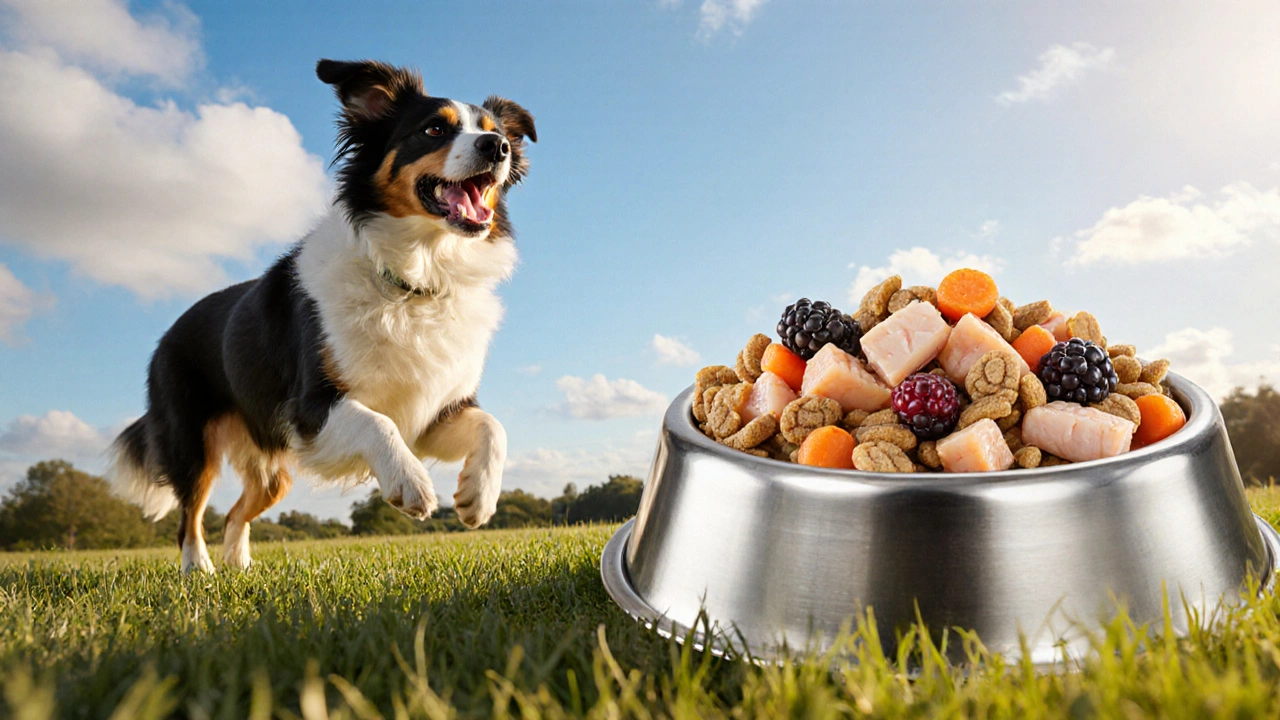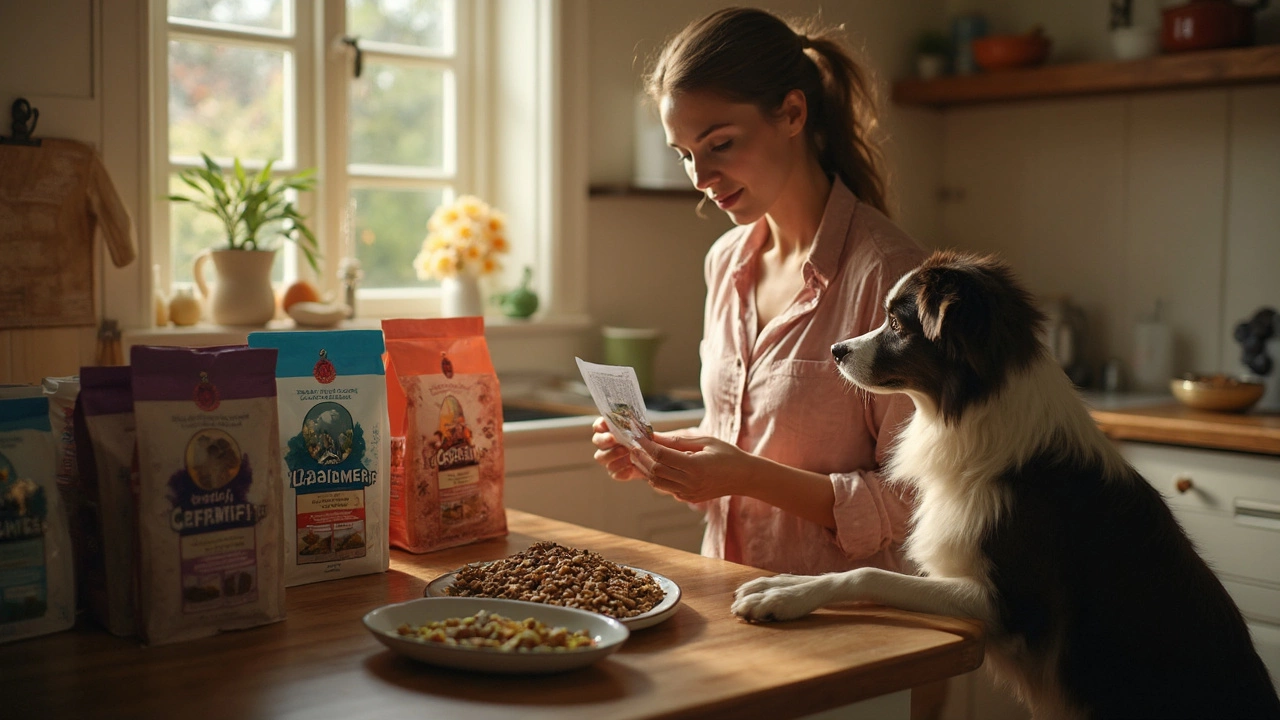Dog Food Guide: Choosing the Right Food for Your Pup
Picking dog food can feel overwhelming, but it doesn’t have to be. The key is to focus on what your dog actually needs: balanced nutrition, tasty variety, and a price that fits your budget. Below you’ll get straight‑forward advice to help you shop with confidence.
Read the Label Like a Pro
First thing’s first – look at the ingredient list. The first three items should be real meat or fish, not filler words like "meal" or "by‑product." A good protein source tells you the food will support muscle health. Next, check for a named source of fat (chicken fat, fish oil) and a clear carbohydrate like sweet potato or brown rice. Avoid artificial colors, flavors, and sweeteners; they add no nutritional value.
Dry, Wet, Raw, or Homemade?
Dry kibble is convenient and helps keep teeth clean, but it can be low in moisture. Wet food adds hydration and often smells more appealing, which is great for picky eaters. Raw or fresh‑frozen diets mimic what wolves eat and can be excellent for dogs with food sensitivities, but they require careful handling. Homemade meals let you control every ingredient, but you’ll need a vet‑approved recipe to keep things balanced.
If you’re unsure which type suits your dog, try a small bag of a new brand for a week. Watch for changes in energy, coat shine, and stool consistency. A quick switch is easier than a long‑term commitment that doesn’t work.
How Much Should You Feed?
Most bags include a feeding chart based on weight, but those numbers are just a starting point. Active dogs burn more calories, seniors need fewer, and puppies need extra for growth. Use the chart, then adjust up or down by about 10% each week while monitoring your dog’s weight.
Give food in two or three meals a day for most adults – it keeps blood sugar stable and helps prevent bloating in deep‑chested breeds. Puppies usually need three to four meals until they’re six months old.
Common Concerns: Grain‑Free, Limited‑Ingredient, and Allergies
Grain‑free foods became popular after a few reports of heart issues, so they’re not a must‑have for every dog. If your pet has a known grain allergy, choose a limited‑ingredient diet that lists a single carbohydrate source. Many dogs do fine on wholesome grains like oats or barley, which provide fiber and steady energy.
For allergies, look for foods that label "novel protein" (such as duck or kangaroo) and avoid common triggers like chicken, beef, dairy, and soy. A short trial of 8‑10 weeks can reveal whether the new diet eases itching or digestive upset.
Budget‑Friendly Tips
Buying in bulk usually saves money, but only if you can store it properly. Vacuum‑sealed bags last months in the pantry. Mixing a high‑quality kibble with an inexpensive wet topper can stretch your budget while keeping meals interesting. You can also add safe, low‑cost boosters like frozen peas, carrots, or a spoonful of plain yogurt.
Remember, cheap doesn’t mean bad if the ingredient list checks the boxes above. Compare the cost per kilogram of protein rather than the total price to see real value.
Transitioning to a New Food
Never switch foods overnight. Blend 25% new food with 75% old food for three days, then 50/50 for another three days, and keep increasing until it’s 100% new. This gradual change reduces digestive upset and lets your dog get used to the new taste.
Keep fresh water available at all times. Proper hydration helps your dog digest food better and keeps the kidneys happy.
With these simple steps – reading labels, picking the right type, feeding the right amount, and watching for allergies – you’ll find a dog food that keeps your pup healthy, energetic, and begging for more. Happy feeding!

Top 3 Dog Food Brands You Should Know
Discover the three leading dog food brands, their key ingredients, price ranges, and how to pick the best fit for your pup's health and budget.
View more
What To Feed Your Dog: Vet-Backed Guide to the Best Dog Food in 2025
Cut through the noise: what to feed your dog, how much, and why. Evidence-based tips, formats compared, brand criteria, and NZ-specific notes.
View more
Is Nutro Good for Dogs? Honest 2025 Review of Ingredients, Safety, and Best Picks
Straight 2025 answer on Nutro: quality, recalls, nutrition, who it fits, smart alternatives, and how to switch-clear, evidence-based, and people-first.
View more
Is Feeding Dogs Once a Day Safe? What Science and Vets Say
Is feeding your dog once a day really safe? Explore vet-backed facts, daily feeding tips, and hear what the latest research says about dog nutrition needs.
View more
Can Dogs Eat Pineapple? Benefits, Risks, and Safe Feeding Tips
Wondering if dogs can have pineapple? Get the facts about the risks, benefits, and safe feeding tips for giving pineapple to your dog from an expert point of view.
View more
Purina vs IAMS: Which Dog and Cat Food Brand Is Better for Your Pet?
Curious whether Purina or IAMS suits your pet best? Dive into a detailed, unbiased comparison, uncover ingredients, quality, price, and which brand fits your pup or kitty.
View more
Do Vets Recommend Farmer's Dog? Honest Insights on Fresh Pet Food
Wondering if vets really stand behind Farmer's Dog food? This article cuts through the hype and shares what practicing veterinarians actually say about fresh, human-grade dog food. You'll get concrete facts about how these meals stack up nutritionally, plus smart tips for talking to your own vet. Expect straightforward answers, up-to-date ideas, and honest perspectives for pet owners who just want the best for their dogs.
View more
Best Homemade Dog Food: What to Feed Your Pup Safely
Thinking about making your dog's meals at home? This article breaks down what homemade food really works best for dogs, which ingredients you should use or avoid, and how to make sure your pup is getting all the nutrients they need. Get easy, practical recipes and pro tips to keep your dog healthy. Learn what vets usually recommend and get answers to common questions real dog owners have. Skip the guesswork and help your furry friend thrive with every meal.
View more
Is Blue Wilderness Good for Dogs? Unpacking the Hype and Ingredients
Wondering if Blue Wilderness is a smart pick for your dog? This article dives into its ingredients, pros and cons, and real feedback from dog owners. You’ll get the facts on how it stacks up for different needs—from picky pups to dogs with allergies. Get answers to whether it’s worth the price and how to transition your pet safely. No fluff, just straight answers to help you make the best choice for your furry friend.
View more
The Healthiest Dog Food: What You Need to Know
Choosing the healthiest dog food can be overwhelming given the countless options. Understanding nutritional needs, reading labels effectively, and comparing choices for your furry friend are crucial parts of the process. Learn about different types of dog food available, ingredients to look for, and key tips to make an informed decision. Proper nutrition plays a significant role in your dog's health and longevity.
View more
What is the Healthiest Food to Feed a Dog?
Choosing the healthiest food for your dog can be confusing with so many options available. It's important to know what nutrients dogs need and how they differ from human nutrition. Learn about the benefits of specific ingredients and how they support your dog's overall well-being. Discover practical tips for selecting the best food to keep your canine companion happy and healthy.
View more
Is Purina Good or Bad for Dogs?
Choosing the right dog food can be overwhelming with so many brands claiming to be the best. Purina, a widely available brand, often gets mixed reviews from dog owners. This article delves into whether Purina is genuinely beneficial for your dog's health or if you might want to consider other options. Let's explore the ingredients, nutritional benefits, and real-life experiences from pet owners.
View more